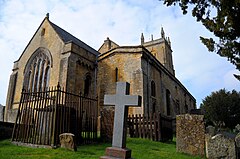 Thomas David Berry was born 8 September 1829 in Blockley, Worcester, England and Baptized on Sunday 18 October 1829 at St Peter and St Paul's Church in Blockley. So began Thomas' lifelong association with the Anglican Church.
Thomas David Berry was born 8 September 1829 in Blockley, Worcester, England and Baptized on Sunday 18 October 1829 at St Peter and St Paul's Church in Blockley. So began Thomas' lifelong association with the Anglican Church. St Peter's and St Paul's sits in the center of town and a church (perhaps the original foundations of the current church) are traced back to at least 1086 and the Domesday Book. In The history of Blockley in the county of Worcester, Alfred J Soden 1875 is found:
In his collections, Bigland describes the parish church of Blockley as consisting of a "spacious nave, and north aisle of the middle ages. The chancel, of the Saxon style, is probably the same structure that is described in Domesday Book."
Rev Soden describes in detail many of the changes, reconstructions and additions made to the church. A major renovation was undertaken in 1838 but overall I believe the church appeared as depicted in this 1871 picture for all of Thomas' time in Blockley.
Also included in the book is this diagram of the inside of the church.
I was unable to find any photos of the inside of the church that I can share here but there are photos of St Peter and Paul's Church, at Church Crawls. The pictures of the interior make the church seem much smaller than the outside views. I wonder at the age of the baptismal font. Was it the one used when Thomas was baptized or was it the one used when for his children?
 The Berry family were poor and the men worked six days a week as agricultural laborers and the women and children worked in the silk mills. I don't know how much of a role the church would have played in their day to day life. I assume, but have not verified, that his parents and two of his children are buried in the cemetery. Thomas, his wife Jane and five of their seven children left the poverty of Blockley behind in 1874 to start a new life in Canada.
The Berry family were poor and the men worked six days a week as agricultural laborers and the women and children worked in the silk mills. I don't know how much of a role the church would have played in their day to day life. I assume, but have not verified, that his parents and two of his children are buried in the cemetery. Thomas, his wife Jane and five of their seven children left the poverty of Blockley behind in 1874 to start a new life in Canada.The family was enumerated on the 1881 census in Gloucester, Russell County (now part of Ottawa, Carleton County), Ontario, Canada. Dist 104, sub dist E, div 2. pg 31, family 142. Thomas gave his occupation as miller and for religion was written England. I have not discovered which church they would have attended at that time but that is where Thomas' youngest child, Amelia, would have been baptized.
Thomas moved to the Bytown section of Ottawa by 1899. On the 1901 census he listed his occupation as sexton. I also had recorded that he was listed as sexton and that he lived at 118 Nelson St. in the 1899 city directory so I started looking on google maps for Anglican churches near Nelson St and I quickly found two. All Saints on Chapel St wasn't old enough but St Alban's on King Edward Ave seemed very likely and I learned quite a bit about the history of the church but found nothing to link the Berry family to it.
So I decided to revisit the city directories to see if I could determine when he moved to Nelson St and when he was first listed as sexton rather than laborer. He is found just outside the city in the 1888-1889 directory and at 66 Nelson St in the 1889-1890 edition. His occupation was given as laborer until the 1895-1896 Ottawa City Directory when he was listed as the sexton of St. John's Church.
 I quickly found St. John the Evangelist Church in Ottawa but after reading the history of the church I learned that the current St John's was Grace Church until 1913. The St John's that Thomas Berry was the sexton of was located at the corner of Sussex and Rue George, less than 3/4 of a mile from where Thomas lived. St John's on Sussex St burned in 1912 so there are no recent photos of the church. I was able to find a photo from c.1870.
I quickly found St. John the Evangelist Church in Ottawa but after reading the history of the church I learned that the current St John's was Grace Church until 1913. The St John's that Thomas Berry was the sexton of was located at the corner of Sussex and Rue George, less than 3/4 of a mile from where Thomas lived. St John's on Sussex St burned in 1912 so there are no recent photos of the church. I was able to find a photo from c.1870.Thomas died in 1907 and his wife, Jane, in 1914 and with their deaths my branch of the Berry family's association with the Anglican church ended. My great-grandfather Joseph and my grandfather, Kimberly were both members of the Congregational Church.
In writing this for the 109th edition of the Carnival of Genealogy I spent several hours learning more about the Church of England and learned much about the history of the religion and a little of the theology but I am left with many unanswered questions such as how Thomas felt about his church and why he chose St John's rather than another?
Carnival Poster by footnote Maven.





No comments:
Post a Comment